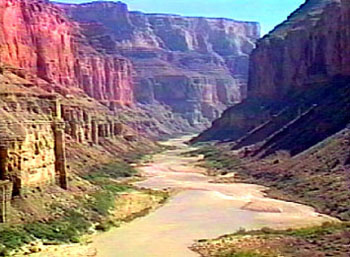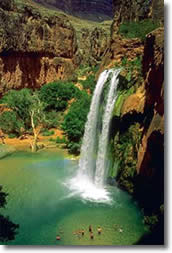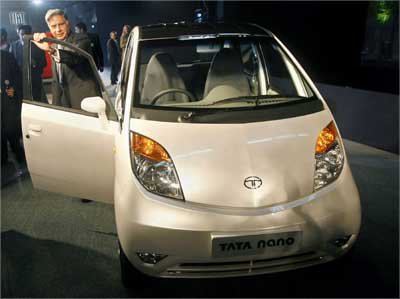The Grand Canyon looks something like this:

Figure 1. Idealized and simplified diagram of the Grand Canyon
There are a number of lava flows on the plateau that the canyon is cut into (yellow in Figure 1, above). These lava flows are Cenozoic in age, and some of them spill into the canyon. The walls of the canyon are mostly cut into horizontal rock layers of Paleozoic age (green in Figure 1, above). There is an angular unconformity at the bottom of the Paleozoic layers. An angular unconformity is the result of tilting and eroding of the lower layers before the upper ones are deposited. These tilted and eroded layers are Precambrian in age (blue in Figure 1, above).
The geological relationships of the various formations are quite clear. The lava flows which spill into the canyon must be younger than the canyon. The canyon must be younger than the rock layers that it cuts into. The sediments above the angular unconformity must be younger than the sediments below it.
The ordering of events which resulted in Figure 1 must be:
The blue layers are deposited.
The blue layers are tilted and eroded.
The green layers are deposited.
The canyon is cut into the green and blue layers.
The lava flows occur.
Even young-earth creationists would agree with this relative sequencing of events. They would argue for a much shorter absolute timescale than mainstream geologists would accept, but the relative sequence is agreed upon by all parties.
ICR’s claims:
 Dr. Steven Austin, chairman of the Geology Department at the Institute for Creation Research, claimed (1992) that he had derived an Rb/Sr isochron for the plateau flows, which indicates an age of about 1.3 billion years.
Dr. Steven Austin, chairman of the Geology Department at the Institute for Creation Research, claimed (1992) that he had derived an Rb/Sr isochron for the plateau flows, which indicates an age of about 1.3 billion years.
One particular Precambrian layer known as the Cardenas Basalt has been dated by radiometric methods to about 1.1 billion years in age. The Cenozoic flows sampled by ICR thus are claimed to yield an age which is about 200 million years older than the Cardenas Basalt. But the Cardenas Basalt cannot be younger than the plateau flows, due to the geological relationships discussed in the first section of this document.
Austin says that his isochron age is the result of a “research project” (1992, p. i) undertaken by the ICR to “test the ages assigned by the best radioactive isotope dating methods” (1992, p. i). Dr. Austin suggests that the slope of his isochron line (indicating great age) is “unexpected” (1992, p. iii) and that his result “challenges the basic assumptions upon which the isochron dating method is based” (1992, p. iv).
In other words, Austin claims that he has produced a seemingly reliable isochron age which must necessarily be wrong, and therefore the Rb-Sr isochron dating method, which is considered to be among the more reliable of radiometric dating methods, must be considered suspect.
Background on ICR’s claims and isochrons:
The damaging paper trail:
 In order to understand what is going on, it is useful to examine the paper trail. Prior to ICR starting the Grand Canyon Dating Project, Austin (1988) produced a similar isochron this time 1.5 billion years for the same lava flows. He used data taken out of a mainstream scientist’s paper (Leeman 1975) to construct the plot.
In order to understand what is going on, it is useful to examine the paper trail. Prior to ICR starting the Grand Canyon Dating Project, Austin (1988) produced a similar isochron this time 1.5 billion years for the same lava flows. He used data taken out of a mainstream scientist’s paper (Leeman 1975) to construct the plot.
Leeman’s paper contains quite a bit more data than Austin used, with sufficient scatter to suggest that the resulting isochron probably is either an “inherited” reflection of the mantle source age or has no significance at all. However, Austin narrowed down the data set to flows which fell into a particular stratigraphic range “stages III and IV of Hamblin’s later classification,” said Austin (1988) and those selected data points fell quite close to a single line.
In his 1988 paper, Austin noted that this sort of “false isochron” is well known, and explained in the mainstream literature. He cited a discussion of it in Faure (1986, pp. 145-147), a popular textbook/handbook on isotope dating methods.
Isochron dating methods:

For general information on isochron dating methods, see talk.origins’ Isochron Dating FAQ. Further information is available in Dalrymple (1991, pp. 102ff), a semi-technical description, and Faure (1986, pp. 117ff), a college-level textbook.
The requirements of isochron dating:
 One of the requirements for an isochron to signify the age of an object, is that the data points be derived from samples of materials which were isotopically homogeneous (with respect to each other) when the object formed, and all separated and ceased chemical exchange at the object’s time of formation. Faure (1986, p. 121) writes, discussing the derivation of the isochron technique from basic principles:
One of the requirements for an isochron to signify the age of an object, is that the data points be derived from samples of materials which were isotopically homogeneous (with respect to each other) when the object formed, and all separated and ceased chemical exchange at the object’s time of formation. Faure (1986, p. 121) writes, discussing the derivation of the isochron technique from basic principles:
If the strontium in such a magma was isotopically homogeneous throughout the cooling period, we may assume that all the diverse rocks that formed from the magma had the same initial 87Sr/86Sr ratio. Moreover, we may assume that the time required for crystallization of the magma was relatively short and that all rocks produced by this process have very nearly the same age. Under these conditions, Equation 8.3 is the equation of a family of straight lines in the slope-intercept form:
That is why isochron results are usually considered reliable if the data points are derived from the individual minerals of a single igneous rock sample, or on multiple samples of a single lava flow. The molten state allows isotopic homogenization, the solidification ceases that process, and therefore the expected result is the time since the solidification occurred.
It is possible for the data points to fall on an isochron line if this requirement is violated. The result will still have the same meaning: the time since all of the samples were isotopically homogenized with respect to each other. However, that result does not have to be the time since each sample formed. Often it will be the isotopic age of the common source of the samples. That result could also be the age of the samples themselves, but only in the case where their common source was isotopically homogeneous i.e., zero-age when the samples formed from it.
For example, as discussed in the talk.origins Age of the Earth FAQ, young Earth sediments and meteorite whole-rock measurements all sit on a Pb/Pb isochron that gives the age of the Solar System:

Figure 2. Pb/Pb isochron of terrestrial and meteorite samples
That isochron tells us the time since the samples were isotopically homogenized with respect to each other the time since the meteorites and Earth formed from the solar nebula. It does not imply that the young Earth sediments themselves are 4.5 billion years old.
This is a well-known and expected behavior of isochrons. No competent geologist would be fooled by this sort of “inherited” isochron age, because it is quite obvious, as the samples are collected, whether the date must reflect the individual samples’ time of formation. This is discussed in more detail in the “Violation of cogenetic requirement” section of the Isochron Dating FAQ.
Criticism of ICR’s claims:
This was not a “test” of Rb-Sr dating:
 It is misleading for Austin to claim that he set out to “test” Rb/Sr isochron dating. The paper trail the 1988 Impact article documents that Austin knew he’d get a mantle age from whole-rock measurements of those lava flows, long before the ICR obtained a single rock sample of their own.
It is misleading for Austin to claim that he set out to “test” Rb/Sr isochron dating. The paper trail the 1988 Impact article documents that Austin knew he’d get a mantle age from whole-rock measurements of those lava flows, long before the ICR obtained a single rock sample of their own.
If isotopic dating methods are as unreliable as Austin would like us to believe, why did he have to rig his test by only selecting rock samples which were known in advance to fail it? If a mainstream scientist were to fix a test in this manner, their reputation would be demolished when that fact was uncovered.
The wrong meaning is assigned to the dates:
 Before the Grand Canyon Dating Project began, in his 1988 Impact article, Austin admitted in print that the selected lava flows fell into two different stratigraphic stages. That is, the very information which he used to select the flows, also clearly indicates that they did not all occur at the same time. In his subsequent book (1994, p. 125), Austin indicated that his five data points came from four different lava flows plus an extracted “phenocryst” (large mineral which likely formed in the magma chamber and was not molten in the lava flow). We had known from the Impact articles that Austin’s samples were not all cogenetic; years later we found out by his own admission that no two of them are so.
Before the Grand Canyon Dating Project began, in his 1988 Impact article, Austin admitted in print that the selected lava flows fell into two different stratigraphic stages. That is, the very information which he used to select the flows, also clearly indicates that they did not all occur at the same time. In his subsequent book (1994, p. 125), Austin indicated that his five data points came from four different lava flows plus an extracted “phenocryst” (large mineral which likely formed in the magma chamber and was not molten in the lava flow). We had known from the Impact articles that Austin’s samples were not all cogenetic; years later we found out by his own admission that no two of them are so.
In fact, as discussed above, the selection of non-cogenetic samples is sometimes used intentionally by isotope geologists. It is known to be a way to have an isochron dating method “look back” beyond a recent event to an earlier event the age of the common source of the samples. Thus, it is misleading for Austin to pretend that his resulting isochron plot should be expected to represent the age of the flows themselves.
A geologist in my acquaintance suggested that this FAQ should be very short:
It should merely state that Austin has confirmed what mainstream geologists have known all along: that the lithospheric mantle underlying the Grand Canyon must be older than the Cardenas Basalt.
The mantle is the source of much of the sampled flows’ material, and Austin’s sampling technique matches the technique one would use to obtain a minimum for the age of the flows’ source.
It’s an insufficient case against isotope dating:
 Austin (1992) suggests that he has “
Austin (1992) suggests that he has “tested
” the dating method. He claims that the false isochron, that he knew would result, is “unexpected
.” He goes as far as implying that all isotopic ages can be ignored when he suggests that nobody has ever “successfully dated a Grand Canyon rock
.” The first two claims are falsehoods, as shown above, and the third cannot be justified by ICR’s Grand Canyon Dating Project.
Young-Earth creationists cannot escape the fact that a large majority of isotope dating results are well-aligned with mainstream predictions, and equally well-aligned with geological relationships which even young-earthers would accept. For example, intrusive formations consistently date as being younger than the formations that they cut across. A laundry-list of anomalous dates will not change that fact. That only shows that the methods sometimes fail, which is not in dispute.
If Austin wishes to make a case that all isotopic results are unreliable (which he desires to do, in order to prop up the timescale that he accepts for religious reasons), he is going to have to do better than he has done here. All the ICR’s Grand Canyon Dating Project shows is that a sample selection geared to yield the age of the flows’ source… apparently does yield the age of the flows’ source.
Summary:
The ICR’s Grand Canyon Dating Project does not strike a telling blow against the reliability of isochron dating. The conditions which caused the “false isochron” in this case are fairly well-understood, and easy to avoid by proper sample selection. In fact, the resulting age in this case may well be meaningful and accurate. The problem is not the age itself but rather Austin’s sleight-of-hand in trying to pass off the result as necessarily the age of the flows rather than a minimum age of their source.
The attempt to abuse the meaning of a single contrived date which was produced only by a sample selection geared to dating a different event, and only for samples whose results were known by Austin in advance says a lot more about the level of competence or honesty in this creation “science” research program, than it says about the validity of isochron dating methods.
Even if given credit for discovering this case (which he clearly doesn’t deserve, as his use of Leeman’s data proves), Austin has only managed to “call into question” a particular sampling technique. However, this sampling technique was known by mainstream geologists to behave in this manner long before Austin published on the topic, and this behavior is often intentionally used by geologists. Austin was aware of this, as his 1988 reference to Faure shows.
Response to Criticisms:
 I recently received a critique of this FAQ. Unfortunately, it was submitted anonymously and it didn’t address the key issues above. Since I couldn’t get permission to reproduce the claims verbatim, I will summarize the creationist claims, and respond to them here. I would recommend that future prospective critics attempt to deal directly and explicitly with the three items in the “criticisms” section above.
I recently received a critique of this FAQ. Unfortunately, it was submitted anonymously and it didn’t address the key issues above. Since I couldn’t get permission to reproduce the claims verbatim, I will summarize the creationist claims, and respond to them here. I would recommend that future prospective critics attempt to deal directly and explicitly with the three items in the “criticisms” section above.
Austin took care to ensure that the samples were cogenetic by selecting lava flows of only Hawaiite basalt, in the same area, which occurred by mainstream reckoning within the last few million years.
The “type” of rock is not sufficient to establish the samples being cogenetic. Since the stratigraphic evidence indicates that the flows did not all occur at the same time, the case could only be made by other isotopic analysis such as taking internal isochrons of the individual flows. That data is lacking from Austin’s published works.
Besides, this line of argument does not address the fact that the result is a known and expected behavior of isochrons. As discussed above, whole-rock samples of multiple flows yields the time since their common source was isotopically homogeneous. It could also be the age of the flows, but it does not have to be. If it is not the flows’ age, that is not a “problem” with isochron dating, and it is not relevant to the large number of Rb/Sr isochrons which were computed from mineral separations of a single object.
Austin’s claims cannot be misleading because he presented this data at a GSA (Geological Society of America) conference and they would not have allowed a dishonest presentation.
At the GSA meeting, Austin discussed the inheritance of a mantle age. He didn’t pretend that the age of the flows was the expected result, and he didn’t make the false claim that his result was sufficient to call all isochron dating into question. This is a transparent attempt to place a GSA “seal of approval” on Austin’s unsupportable Impact claims. (In my opinion, the anonymous critic is engaging in a little sleight-of-hand of his own.)
An Impact article is so short that only a single point can be made, therefore Austin should be excused for a misleading or inaccurate appearance to his statements which might simply be a result of brevity. Those wishing the full argument should look to Austin’s book instead.
The length of the medium is not a legitimate excuse for a blatant falsehood (the claim that Austin set out to “test” Rb/Sr dating) or for the shenanigans involving the sampling technique versus the expected meaning of the resulting age. Further, there is no material in Austin’s book which legitimizes the false and misleading claims in his Impact article.
In addition, the Impact articles (which are free and available online) receive much wider distribution than Austin’s book (which costs $20). At least a dozen creationists arguing against isotope geology have referred me to the Impact articles, and not a single one of them had ever looked at the book. The claims in Impact are all that most creationists ever see. Therefore they must be accurate on their own.
References:
Austin, Steven A., ed., 1994. Grand Canyon: Monument to Catastrophe. Plus Communications, ISBN 0-932766-33-1.
Back to “wrong meaning”
Austin, Steven A., 1992. “Excessively Old “Ages” For Grand Canyon Lava Flows,” in Impact #224 (February).
Back to “ICR claims” or “insufficient case”
Austin, Steven A., 1988. “Grand Canyon lava flows: A survey of isotope dating methods,” in Impact #178 (April).
Back to “paper trail” or “not a test”
Dalrymple, G. Brent, 1991. The Age of the Earth. California: Stanford University Press, ISBN 0-8047-1569-6.
Back to “isochron dating methods”
Faure, Gunter, 1986. Principles of Isotope Geology, Second Edition. New York: John Wiley and Sons, ISBN 0-471-86412-9.
Back to “fictitious isochrons”, “isochron dating”, or “isochron requirements”
Leeman, W. P., 1974. “Late Cenozoic Alkali-Rich Basalt from the Western Grand Canyon Area, Utah and Arizona: Isotopic Composition of Strontium” in Geological Society of America Bulletin 85 (November), pp. 1691-1696.
Back to “paper trail”




















